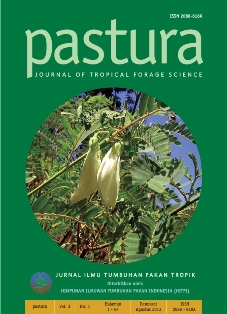PERILAKU MAKAN RUMINANSIA SEBAGAI BIOINDIKATOR FENOLOGI DAN DINAMIKA PADANG PENGGEMBALAAN
Abstract
Grazing land or rangeland is an “eating table” of ruminants and/or other herbivores for supporting their life. The adequacy and uptake of essential nutrients such as dry matter, protein and energy are very much determined by quality and phenology of pasture vegetation. The phenology of grass influences directly to ingestive behaviour of the herbivores. During grazing time, ruminant animals/herbivores tend to select the pastures that are easy to be prehended for fulfilling their dry matter requirement. Therefore, monitoring and recording the diurnal ingestive or grazing behaviour of ruminant animals or other herbivores would be as useful bioindicator for understanding the change of growth and availability of grass on pasture and/or rangeland. This behavioral aspect of ruminants is also useful clue and effective information to be considered for managing the grassland developments. This paper reviews and discusses the ingestive behaviour of ruminants as one of bioindicators determining the phenology of grass and dynamics of grasslands or rangelands.Downloads
Download data is not yet available.
How to Cite
YASIN, Suhubdy.
PERILAKU MAKAN RUMINANSIA SEBAGAI BIOINDIKATOR FENOLOGI DAN DINAMIKA PADANG PENGGEMBALAAN.
Pastura, [S.l.], v. 3, n. 1, june 2014.
ISSN 2549-8444.
Available at: <https://ojs.unud.ac.id/index.php/pastura/article/view/9032>. Date accessed: 15 jan. 2026.
doi: https://doi.org/10.24843/Pastura.2013.v03.i01.p01.
Issue
Section
Articles
Keywords
bioindicator, ingestive behaviour, plants phenology, pastures, rangelands.





